RSI - A Structured Approach Use Cases and HCI Design
RSI - A Structured Approach Use Cases and HCI Design
RSI - A Structured Approach Use Cases and HCI Design
You also want an ePaper? Increase the reach of your titles
YUMPU automatically turns print PDFs into web optimized ePapers that Google loves.
The <strong>RSI</strong> <strong>Approach</strong> To <strong>HCI</strong> <strong>Design</strong> / <strong>Use</strong> Case Analysis Page 37 of 42<br />
4.7. Process Variations<br />
A process should at least reflect the cause <strong>and</strong> effect dependencies that exist between its<br />
deliverables. In the case of <strong>RSI</strong>, these are that:<br />
• an essential service use case is dependent on one or more steps within the requirement<br />
use case model;<br />
• an interface use cases is dependent on one or more steps within the requirement use case<br />
model;<br />
• a non-essential service use case (those in the consolidated services use case model) is<br />
dependent on one or more interface use cases;<br />
So theoretically at least, we could envisage a project in which the service use cases <strong>and</strong><br />
interface use cases were developed as each step within the requirement use case emerged. The<br />
downside of this approach is that it would lead to piecemeal development of service use cases<br />
<strong>and</strong> interface use cases, which did not consider the more holistic aspects of the analysis <strong>and</strong><br />
design process. Hence the emphasis on project increments within <strong>RSI</strong>. A more holistic view<br />
of the dependencies between <strong>RSI</strong> deliverables is thus that:<br />
• essential service use cases are dependent on steps within the current increment's<br />
requirement use cases;<br />
• interface use cases are dependent on one or more steps within the current increment's<br />
requirement use cases;<br />
• non-essential service use cases (those in the consolidated service use case model) are<br />
dependent on the current increment's interface use case;<br />
Given this, the following processes could be used for developing the <strong>RSI</strong> models:<br />
Variation 1:<br />
1. The current increment's requirement use cases are first developed in full;<br />
2. The essential service use case model is developed;<br />
3. The interface use case model is developed;<br />
4. The consolidated service use case <strong>and</strong> traceability model is developed;<br />
Variation 2:<br />
1. The current increment's requirement use cases are first developed in full;<br />
2. The interface use case model is developed;<br />
3. The consolidated service use case <strong>and</strong> traceability model is developed;<br />
Both of these approaches maintain the holistic dependencies chain detailed earlier. Experience<br />
has shown that the downside of both these approaches is that they loose the potential synergy<br />
of developing the interface use case <strong>and</strong> service use case model together (generally in a small<br />
team), <strong>and</strong> so they should not be considered unless circumstances dictate that the preferred<br />
process is not viable.<br />
W5a - <strong>RSI</strong> LONG PAPER [42 PAGES].doc( Rev: 5) - 03/09/00











